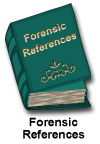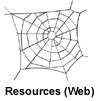|
|
 |
The
required readings for this unit are:
 Australia
Australia |
Required
Reading(s)
|
 |
Insert article
here......................
 Canada
Canada |
Required
Reading(s)
|
 |
Insert article
here......................
 International
International |
Required
Reading(s)
|
 |
Insert article
here......................
 United Kingdom
United Kingdom |
Required
Reading(s)
|
 |
| Edmondston,
J. (1999). What would Sherlock Holmes |
have
thought of forensic DNA profiling? Australian
Science Teachers Journal, 45(1), 11-14. Retrieved
December 20, 2002, from EPSCO Database - Academic
Search Premier:
http://search.epnet.com/direct.asp?an=1907583&db=aph
- Provides
information on the use of DNA analysis in crime-solving.
History of forensic DNA profiling;
Possibility of similarity of DNA profiles of two
individuals; Paternity testing; Identification of
bodies damaged beyond recognition; Establishment
of DNA banks.
|
 United States
United States |
Required
Reading(s)
|
 |
| Friedman,
A. L. (1999). Forensic DNA profiling in the |
21st
century. International Journal of
Offender Therapy and Comparative Criminology, 43(2),
168-179. Retrieved December 20, 2002, from EPSCO
Database - Academic Search Premier:
http://search.epnet.com/direct.asp?an=2169892&db=aph
- Predicts
the state of forensic DNA profiling in the 21st
century. Background on the use of DNA profiling
in criminal justice; Serology; DNA testing history;
Mitochondrial DNA; Future of DNA evidence.
|
Databases
For the full text article online,
sleuth the 'University
of Calgary/ Library/ Article Indexes':
Directions:
- Select
- Indexes and abstracts with links to full text articles
- Select
- Academic Search Premier or Expanded Academic ASAP
- Select
- Connect
-
Fill in
User ID and Pin
- Fill
in search words:
DNA
Top of Page
|
 |
 |
The
'recommended only' readings for this unit are the following:
 Australia
Australia |
Recommended
Reading(s)
|
 |
Insert article/book/chapter
here……..
 Canada
Canada |
Recommended
Reading(s)
|
 |
| Silversides,
A. (2001). Lessons Canada learned in |
Swissair
crash being applied in New York Canadian Medical
Association Journal, 165(9), 1243. Retrieved
July 2, 2002, from ProQuest database.
- After
Swissair Flight 111 crashed into Peggy's Cove Sept.
2, 1998, killing everyone on board, the Ontario
coroner spent 3 weeks in Halifax, working with Nova
Scotia medical examiner John Butt in the
most massive body-identification job in Canadian
history.
- Butt,
who dealt extensively with traumatized families
in the wake of the Swissair crash, suggested another
lesson from that disaster: establish a protocol
for dealing with human remains - the extent and
type of DNA testing that will be conducted
and what will be done with the remains - and then
publicize it.
|
 International
International |
Recommended
Reading(s)
|
 |
Insert article/book/chapter
here……..
 United Kingdom
United Kingdom |
Recommended
Reading(s)
|
 |
Insert article/book/chapter
here……..
 United States
United States |
Recommended
Reading(s)
|
 |
| Derksen,
L. (2000). Towards a sociology of |
measurement:
The meaning of measurement error in the case of
DNA profiling. Social Studies of Science, 30(6),
803-845. Retrieved December 20, 2002, from Academic
Search Premier:
http://search.epnet.com/direct.asp?an=6151768&db=aph
- This
paper examines an inflammatory subject - 'DNA typing'
(or 'DNA fingerprinting' as it is popularly called)
- to show how credible scientific knowledge is produced
through the systematic erasure of uncertainty and
random variation.
|
| Dix, K.
(2002, October/November). Advancing Forensic |
Science:
A New Buccal DNA Collector. Forensic Nurse Magazine.
Retrieved Oct 15, 2002, from http://www.forensicnursemag.com/articles/2a1feat3.html
- Although
non-invasive methods of DNA gathering are a boon
in terms of comfort, they carry the disadvantage
of reduced efficiency. Some research companies,
however, have focused their efforts on improving
the efficiency while retaining the ease of collection.
|
| Ledray,
L. E. & Netzel, L. (1997). DNA evidence |
collection.
Journal of Emergency Nursing, 23(2), 156-158.
|
|
Pyek, K.
M. (2002, October/November). Battling the
|
Backlog,
Crime Labs Juggle Priorities, Add New Technology
To Address Growing Need For DNA Analysis. Forensic
Nurse Magazine. Retrieved Oct 15, 2002, from http://www.forensicnursemag.com/articles/2a1feat2.html
- As legislation
addressing the DNA backlog continues to circulate
through Congress at the time of writing, continued
emphasis is being placed on the expedition of the
analysis of biological material connected with rapes
and other violent crimes.
|
Top of Page
|

|
Additional
references for this unit can be found in 'forensic
references'
of the forensic sourcebooks.
- Sleuth
'forensic reference' database for:
DNA
Top of Page
|

|
Video's
recommended for this unit are:
|
|
Resources
(Video)
|
 |
Insert video
here
Top of Page
|

|
The
required websites to sleuth for this unit are the following:
 Australia
Australia |
Resources
(Web)
|
 |
Insert website
here……..
- Note in this
website.....
 Canada
Canada |
Resources
(Web)
|
 |
Insert website
here……..
- Note in this
website.....
 International
International |
Resources
(Web)
|
 |
Insert website
here……..
- Note in this
website.....
 United Kingdom
United Kingdom |
Resources
(Web)
|
 |
Insert website
here……..
- Note in this
website.....
 United States
United States
|
Resources
(Web)
|
 |
Riley, D. E.
(1998). DNA testing: An introduction for non-scientists,
an illustrated explanation. Scientific Testimony. Website:
http://www.scientific.org/tutorials/articles/riley/riley.html
- Note the four
basic steps used in comparing a reference DNA sample to
a crime-scene sample.
The why files
of education (2002). We're going to talk about forensic
science. Retrieved may 18, 2002 from http://whyfiles.news.wisc.edu/014forensic/index.html
- Note this
interesting site for teens on many aspects of forensic
science: DNA, fingerprinting etc.
Top of Page
|
 |
For
additional websites on this unit, sleuth 'forensic
websites' in the forensic sourcebooks.
Top of Page
|
 |
|